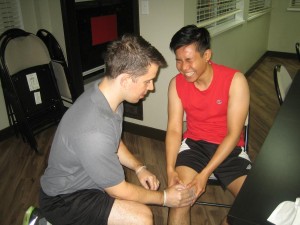Hyperextended knee happens when the knee is extended more than the normal range of extension, which is a type of knee injury that happens with an excessive pressure or force that causes the knee to bend backwards.
Hyperextended knee can damage the knee cartilage, menisci and the ligament. It also puts the individual at higher risk to develop arthritis later on. This injury can occur in both children and adults. Since children still have developing bones, a minor fracture on the knee due to wide-range stretching of the ligaments or tendon of the knee can occur.
Hyperextended knee can be mild or severe. When it comes to the mild cases, they can be treated with rest and some physical therapy and heals within 3-4 weeks. As for severe cases, it is best to consult a doctor for proper assessment of the condition.
Causes of hyperextended knee
- Hyperextended occurs when the legs bears the weight of body such as standing with his/her legs are being extended. This will cause backward extension of the knee more than its normal range.
- An incorrect landing from a high jump can cause pressure on the knee to bend backwards.
- People engaged in gymnastics and playing volleyball are also prone to this injury.
- People running or walking and suddenly lands up in a pothole can lead to mild or severe injuries and usually depends on the degree of damage on parts of the knee such as the tendons, ligaments, cartilage and menisci.
Symptoms of a hyperextended knee

- A popping sound can be heard in the joint of the knee and a feeling that the knee is disconnected.
- There is a severe pain after the injury and can be felt at side and back of the knee.
- Swelling of the knee will develop after an hour after the injury was sustained.
- The knee becomes unstable and there is difficulty in positioning the knee while playing or running.
- The appearance of the affected leg is curved backwards.
Treatment and home remedies of hyperextended knees
- Immediately after the injury, avoid putting any weight on the affected knee. The individual should wear crutches or be given support by another individual when moving to a safe place.
- Rest the affected limb. The individual should avoid playing sports or other activities that will make the condition worse.
- Elevate the legs above the level of the heart when lying down since it helps reduce the swelling.
- Apply a compression bandage around the knee in order to help minimize swelling and pain.
- Apply an ice pack or compress over the affected area in order to minimize swelling and pain. Take anti-inflammatory medications to lessen the pain and minimize swelling.
- Seek the help of a physical therapist for exercises to improve the strength of the knee joint and restore normal range of motion.
